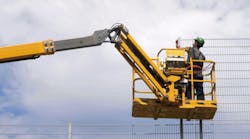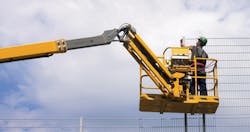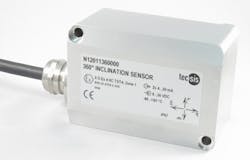Most forklift trucks used in warehouses pose no great challenge to keep loads level because floors are level. Generally, an operator keeps loads level simply by actuating a hydraulic valve to control cylinders that tilt the vehicle's forks backward. Such is not the case with all-terrain forklifts, where uneven and unstable ground are expected. Keeping loads level on aerial work platforms is even more critical because the load usually consists of people.
Level sensors (inclinometers) were developed to provide feedback to a machine control to keep loads level. Today’s closed-loop electrohydraulic systems can provide automatic leveling. To accomplish this, the inclinometer sends an analog-based signal to the machine’s control, which then commands a proportional hydraulic valve to shift one way or the other to keep the load level.
Traditional inclinometers monitor a single axis of orientation — typically roll or pitch. However, the Model LPI inclination sensor from tecsis LP, Worthington, Ohio, monitors orientation in two axes. This sensor can be configured to provide dynamic or static incline or tilt angles between 0 to 360° (single axis) or ±45° (dual axis) with a resolution of 0.01°. Predefined measuring ranges can be selected to suit the application, and switch outputs provide control based on limit angles.
The Model LPI’s IP67-rated aluminum housing makes it well suited for use in industrial and outdoor environments. It also provides consistent output in ambient temperatures from –40 to 185°F and exhibits no gravitational error. Standard output is CSA approved intrinsically safe 4-to-20 mA, with 0 to 5 Vdc and CANopen also available.
For more information on the LPI sensor, call tecsis at (614) 430-0683 or click here.



